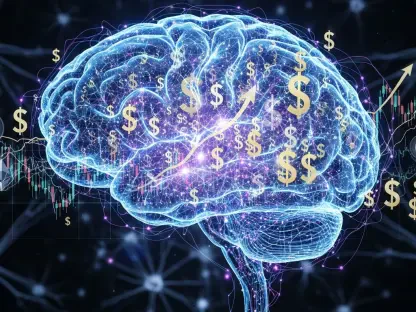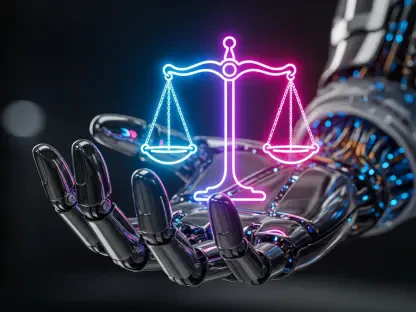Setting the Stage for AI in Justice Systems
In an era where technology permeates every facet of life, consider a courtroom where algorithms assist in determining the fate of individuals—analyzing evidence, predicting outcomes, and even suggesting sentences in mere seconds, transforming what was once science fiction into a tangible reality. Artificial Intelligence (AI) is now stepping into the judicial arena, offering the promise of faster, more consistent decisions, yet raising significant concerns about bias and accountability. This review delves into the integration of AI in judicial decision-making, exploring its capabilities, real-world applications, and the profound challenges it poses to the justice system.
The rise of AI in legal contexts stems from a pressing need to address inefficiencies in overburdened court systems worldwide. With case backlogs stretching judicial resources thin, the technology offers a potential lifeline by automating routine tasks and providing data-driven insights. However, as this tool gains traction, critical questions emerge about its role—whether it should merely assist or take on more autonomous functions. This analysis aims to unpack the current state of AI in judicial processes, assessing its strengths and limitations through a technological lens.
Core Features and Performance of AI in Judicial Contexts
Data Processing and Operational Efficiency
At the heart of AI’s appeal in judicial systems lies its unparalleled ability to process vast datasets with speed and precision. Legal documents, case precedents, and evidence can be sifted through in a fraction of the time it takes human clerks or judges, significantly reducing delays in case management. Performance metrics from pilot programs reveal that AI systems can handle thousands of documents daily, streamlining administrative burdens and allowing courts to focus on substantive issues.
Beyond raw speed, the technology enhances operational workflows by categorizing and prioritizing cases based on complexity or urgency. In jurisdictions experimenting with AI, backlog reductions of up to 30% have been reported, showcasing its potential to transform court efficiency. Yet, this efficiency comes with a caveat—reliance on digital infrastructure and the quality of input data can make or break the system’s effectiveness, raising concerns about accessibility in under-resourced regions.
Predictive Analytics and Decision Support Tools
Another cornerstone of AI in judicial settings is its use of predictive analytics to support decision-making. By analyzing historical data, these systems generate insights on sentencing guidelines, recidivism risks, and bail determinations, offering judges a data-backed perspective. Accuracy levels in some tools reach upwards of 80% in predicting outcomes based on past patterns, positioning AI as a valuable aid in striving for consistency across rulings.
However, the technology struggles to capture the nuanced human elements of justice, such as cultural context or emotional testimony, which often play a pivotal role in decisions. While it excels as a decision-support mechanism, over-dependence on algorithmic outputs risks sidelining judicial discretion. The performance of predictive tools also varies widely depending on the diversity and integrity of training data, highlighting a critical limitation in their current deployment.
Recent Innovations and Emerging Trends
The landscape of AI in judicial applications is evolving rapidly, with advancements in natural language processing enabling deeper analysis of legal texts and contracts. These innovations allow systems to interpret complex language with greater accuracy, assisting in drafting opinions or identifying relevant precedents. Over the next few years, from 2025 to 2027, expect further refinement in these capabilities as machine learning models become more sophisticated.
A notable trend is the growing debate over AI autonomy in courtrooms, with discussions shifting toward defining boundaries between human oversight and machine input. Legal industry perspectives are increasingly focused on hybrid models where AI handles procedural tasks while judges retain final authority. Global pilot programs are also gaining momentum, testing the waters for broader integration and shaping policies on ethical implementation.
Additionally, there is a rising emphasis on transparency in AI systems, driven by public and professional demand for clarity on how decisions are influenced by algorithms. Developers are now prioritizing explainable AI frameworks to demystify the black-box nature of these tools. This shift reflects a broader recognition that trust is paramount if the technology is to gain widespread acceptance in judicial spheres.
Real-World Implementations and Case Studies
Across various jurisdictions, AI is already making its mark in judicial settings, offering a glimpse into its practical utility. In some regions, tools assist with bail decisions by assessing risk factors based on defendant profiles, providing judges with structured recommendations. Early results indicate a reduction in arbitrary rulings, though disparities in outcomes raise questions about underlying data biases.
Sentencing recommendations represent another area of application, where AI systems draw on historical sentencing data to suggest penalties. A notable case study from a European jurisdiction demonstrated a marked increase in uniformity across similar cases, yet also flagged instances where the tool overemphasized certain factors, leading to contested outcomes. These implementations underscore the technology’s dual nature—helpful yet imperfect.
Unique use cases also include AI-driven procedural assistance, such as automating the scheduling of hearings or summarizing lengthy case files for quick review. While these applications have yielded time savings, they occasionally falter in handling atypical cases, revealing gaps in adaptability. Such real-world examples highlight both the transformative potential and the pitfalls that must be navigated as adoption expands.
Challenges and Barriers to Adoption
Despite its promise, AI in judicial decision-making faces significant hurdles, chief among them being the risk of embedded biases in training data. If historical data reflects systemic inequities, the algorithms can perpetuate or even amplify these issues, leading to unfair outcomes. Efforts to mitigate this through diverse datasets and regular audits are underway, though progress remains uneven.
Accountability poses another formidable challenge, as errors in AI recommendations raise complex questions about liability. Determining responsibility—whether it lies with developers, deploying agencies, or end-users—remains unresolved, creating legal gray areas. Current frameworks are often ill-equipped to address such scenarios, necessitating urgent updates to regulatory structures.
Societal risks further complicate the picture, with potential erosion of public trust in justice systems if AI decisions are perceived as opaque or detached. The fear of delegating life-altering rulings to machines could undermine the legitimacy of legal institutions. Addressing these concerns requires not only technical solutions but also robust public engagement to ensure the technology aligns with societal values.
Looking Ahead: Future Prospects and Considerations
Reflecting on the journey of AI in judicial decision-making, the technology has demonstrated remarkable potential to enhance efficiency and consistency in an overburdened justice system. Its capacity to process data and support decisions stands out as a game-changer, though tempered by persistent issues of bias and accountability. The real-world applications provide valuable lessons, revealing both successes and areas needing refinement.
Moving forward, stakeholders must prioritize the development of unbiased algorithms through rigorous data vetting and inclusive design practices. Establishing clear liability frameworks will be essential to balance innovation with responsibility, ensuring that errors do not leave victims without recourse. Collaboration between technologists, legal experts, and policymakers can pave the way for such solutions.
Equally critical is fostering public trust through transparency and education about AI’s role in justice. Initiatives to demystify algorithmic processes and involve communities in shaping guidelines could bridge the gap between technology and societal acceptance. As the integration of AI deepens, a commitment to preserving human judgment as the cornerstone of justice will guide its responsible evolution, safeguarding both efficiency and equity in the legal landscape.









